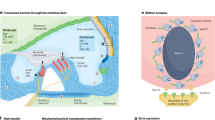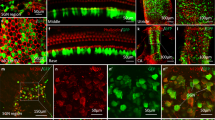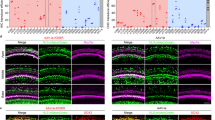Abstract
Because there are currently no biological treatments for hearing loss, we sought to advance gene therapy approaches to treat genetic deafness. We focused on Usher syndrome, a devastating genetic disorder that causes blindness, balance disorders and profound deafness, and studied a knock-in mouse model, Ush1c c.216G>A, for Usher syndrome type IC (USH1C). As restoration of complex auditory and balance function is likely to require gene delivery systems that target auditory and vestibular sensory cells with high efficiency, we delivered wild-type Ush1c into the inner ear of Ush1c c.216G>A mice using a synthetic adeno-associated viral vector, Anc80L65, shown to transduce 80–90% of sensory hair cells. We demonstrate recovery of gene and protein expression, restoration of sensory cell function, rescue of complex auditory function and recovery of hearing and balance behavior to near wild-type levels. The data represent unprecedented recovery of inner ear function and suggest that biological therapies to treat deafness may be suitable for translation to humans with genetic inner ear disorders.
This is a preview of subscription content, access via your institution
Access options
Access Nature and 54 other Nature Portfolio journals
Get Nature+, our best-value online-access subscription
$29.99 / 30 days
cancel any time
Subscribe to this journal
Receive 12 print issues and online access
$209.00 per year
only $17.42 per issue
Buy this article
- Purchase on Springer Link
- Instant access to full article PDF
Prices may be subject to local taxes which are calculated during checkout







Similar content being viewed by others
References
Chien, W.W. et al. Gene therapy restores hair cell stereocilia morphology in inner ears of deaf whirler mice. Mol. Ther. 24, 17–25 (2016).
Askew, C. et al. Tmc gene therapy restores auditory function in deaf mice. Sci. Transl. Med. 7, 295ra108 (2015).
Akil, O. et al. Restoration of hearing in the VGLUT3 knockout mouse using virally mediated gene therapy. Neuron 75, 283–293 (2012).
Boughman, J.A., Vernon, M. & Shaver, K.A. Usher syndrome: definition and estimate of prevalence from two high-risk populations. J. Chronic Dis. 36, 595–603 (1983).
Smith, R.J. et al. Clinical diagnosis of the Usher syndromes. Am. J. Med. Genet. 50, 32–38 (1994).
Vernon, M. Usher's syndrome--deafness and progressive blindness. Clinical cases, prevention, theory and literature survey. J. Chronic Dis. 22, 133–151 (1969).
Weil, D. et al. Defective myosin VIIA gene responsible for Usher syndrome type 1B. Nature 374, 60–61 (1995).
Weston, M.D. et al. Myosin VIIA mutation screening in 189 Usher syndrome type 1 patients. Am. J. Hum. Genet. 59, 1074–1083 (1996).
Adato, A. et al. Mutation profile of all 49 exons of the human myosin VIIA gene, and haplotype analysis, in Usher 1B families from diverse origins. Am. J. Hum. Genet. 61, 813–821 (1997).
Liu, X.Z., Newton, V.E., Steel, K.P. & Brown, S.D. Identification of a new mutation of the myosin VII head region in Usher syndrome type 1. Hum. Mutat. 10, 168–170 (1997).
Bitner-Glindzicz, M. et al. A recessive contiguous gene deletion causing infantile hyperinsulinism, enteropathy and deafness identifies the Usher type 1C gene. Nat. Genet. 26, 56–60 (2000).
Verpy, E. et al. A defect in harmonin, a PDZ domain-containing protein expressed in the inner ear sensory hair cells, underlies Usher syndrome type 1C. Nat. Genet. 26, 51–55 (2000).
Bolz, H. et al. Mutation of CDH23, encoding a new member of the cadherin gene family, causes Usher syndrome type 1D. Nat. Genet. 27, 108–112 (2001).
Bork, J.M. et al. Usher syndrome 1D and nonsyndromic autosomal recessive deafness DFNB12 are caused by allelic mutations of the novel cadherin-like gene CDH23. Am. J. Hum. Genet. 68, 26–37 (2001).
Ahmed, Z.M. et al. Mutations of the protocadherin gene PCDH15 cause Usher syndrome type 1F. Am. J. Hum. Genet. 69, 25–34 (2001).
Alagramam, K.N. et al. The mouse Ames waltzer hearing-loss mutant is caused by mutation of Pcdh15, a novel protocadherin gene. Nat. Genet. 27, 99–102 (2001a).
Alagramam, K.N. et al. Mutations in the novel protocadherin PCDH15 cause Usher syndrome type 1F. Hum. Mol. Genet. 10, 1709–1718 (2001b).
Weil, D. et al. Usher syndrome type I G (USH1G) is caused by mutations in the gene encoding SANS, a protein that associates with the USH1C protein, harmonin. Hum. Mol. Genet. 12, 463–471 (2003).
Riazuddin, S. et al. Alterations of the CIB2 calcium- and integrin-binding protein cause Usher syndrome type 1J and nonsyndromic deafness DFNB48. Nat. Genet. 44, 1265–1271 (2012).
Boëda, B. et al. Myosin VIIa, harmonin and cadherin 23, three Usher I gene products that cooperate to shape the sensory hair cell bundle. EMBO J. 21, 6689–6699 (2002).
Lefèvre, G. et al. A core cochlear phenotype in USH1 mouse mutants implicates fibrous links of the hair bundle in its cohesion, orientation and differential growth. Development 135, 1427–1437 (2008).
Grillet, N. et al. Harmonin mutations cause mechanotransduction defects in cochlear hair cells. Neuron 62, 375–387 (2009).
Michalski, N. et al. Harmonin-b, an actin-binding scaffold protein, is involved in the adaptation of mechanoelectrical transduction by sensory hair cells. Pflugers Arch. 459, 115–130 (2009).
Gregory, F.D. et al. Harmonin inhibits presynaptic Cav1.3 Ca2 channels in mouse inner hair cells. Nat. Neurosci. 14, 1109–1111 (2011).
Gregory, F.D., Pangrsic, T., Calin-Jageman, I.E., Moser, T. & Lee, A. Harmonin enhances voltage-dependent facilitation of Cav1.3 channels and synchronous exocytosis in mouse inner hair cells. J. Physiol. (Lond.) 591, 3253–3269 (2013).
Lentz, J.J. et al. Deafness and retinal degeneration in a novel USH1C knock-in mouse model. Dev. Neurobiol. 70, 253–267 (2010).
Lentz, J., Pan, F., Ng, S.S., Deininger, P. & Keats, B. Ush1c216A knock-in mouse survives Katrina. Mutat. Res. 616, 139–144 (2007).
Lentz, J. et al. The USH1C 216G→A splice-site mutation results in a 35-base-pair deletion. Hum. Genet. 116, 225–227 (2005).
Landegger, L. et al. A synthetic AAV vector enables safe and efficient gene transfer to the mammalian inner ear. Nat. Biotechnol. http://dx.doi.org/10.1038/nbt.3781 (2017).
Lentz, J.J. et al. Rescue of hearing and vestibular function by antisense oligonucleotides in a mouse model of human deafness. Nat. Med. 19, 345–350 (2013).
Gale, J.E., Marcotti, W., Kennedy, H.J., Kros, C.J. & Richardson, G.P. FM1-43 dye behaves as a permeant blocker of the hair-cell mechanotransducer channel. J. Neurosci. 21, 7013–7025 (2001).
Meyers, J.R. et al. Lighting up the senses: FM1-43 loading of sensory cells through nonselective ion channels. J. Neurosci. 23, 4054–4065 (2003).
Géléoc, G.S. & Holt, J.R. Developmental acquisition of sensory transduction in hair cells of the mouse inner ear. Nat. Neurosci. 6, 1019–1020 (2003).
Zinn, E. et al. In silico reconstruction of the viral evolutionary lineage yields a potent gene therapy vector. Cell Rep. 12, 1056–1068 (2015).
Kho, S.T., Pettis, R.M., Mhatre, A.N. & Lalwani, A.K. Safety of adeno-associated virus as cochlear gene transfer vector: analysis of distant spread beyond injected cochleae. Mol. Ther. 4, 368–373 (2000).
Bedrosian, J.C. et al. In vivo delivery of recombinant viruses to the fetal murine cochlea: transduction characteristics and long-term effects on auditory function. Mol. Ther. 14, 328–335 (2006).
Wang, L., Jiang, H. & Brigande, J.V. Gene transfer to the developing mouse inner ear by in vivo electroporation. J. Vis. Exp. 64, 3653 (2012).
Depreux, F.F. et al. Antisense oligonucleotides delivered to the amniotic cavity in utero modulate gene expression in the postnatal mouse. Nucleic Acids Res. 44, 9519–9529 (2016).
Clark, K.R., Sferra, T.J. & Johnson, P.R. Recombinant adeno-associated viral vectors mediate long-term transgene expression in muscle. Hum. Gene Ther. 8, 659–669 (1997).
Duan, D. et al. Circular intermediates of recombinant adeno-associated virus have defined structural characteristics responsible for long-term episomal persistence in muscle tissue. J. Virol. 72, 8568–8577 (1998).
Noben-Trauth, K., Zheng, Q.Y. & Johnson, K.R. Association of cadherin 23 with polygenic inheritance and genetic modification of sensorineural hearing loss. Nat. Genet. 35, 21–23 (2003).
Kane, K.L. et al. Genetic background effects on age-related hearing loss associated with Cdh23 variants in mice. Hear. Res. 283, 80–88 (2012).
Lelli, A., Asai, Y., Forge, A., Holt, J.R. & Géléoc, G.S. Tonotopic gradient in the developmental acquisition of sensory transduction in outer hair cells of the mouse cochlea. J. Neurophysiol. 101, 2961–2973 (2009).
Stauffer, E.A. & Holt, J.R. Sensory transduction and adaptation in inner and outer hair cells of the mouse auditory system. J. Neurophysiol. 98, 3360–3369 (2007).
Zheng, L., Zheng, J., Whitlon, D.S., García-Añoveros, J. & Bartles, J.R. Targeting of the hair cell proteins cadherin 23, harmonin, myosin XVa, espin, and prestin in an epithelial cell model. J. Neurosci. 30, 7187–7201 (2010).
Acknowledgements
This work was supported by the Manton Center for Orphan Disease Pilot Award 2011 to G.S.G. (Boston Children's Hospital), the Bertarelli Foundation, Program in Translational Neuroscience and Neuroengineering, Kidz-b-Kidz Foundation (now Arts for USH), the Jeff and Kimberly Barber Gene Therapy Research Fund and a consortium agreement under a primary award from the Foundation Fighting Blindness, Cost Center #7 5794 (P.I. L. Vandenberghe). A.A.I. received support from R01DC000304 (DP Corey). S.H.-A. was the recipient of the diversity faculty fellowship award from Harvard Medical School. Behavior and Viral Cores at Boston Children's Hospital are supported by the Boston Children's Hospital Intellectual and Developmental Disabilities Research Center (BCH IDDRC), P30 HD18655. M. Hastings' contribution was supported by R01DC012596. We thank M. Valero (EPL, MEEI) for assistance with ABRs, S. Xu (BCH core) for help with the behavior work, C. Wang (BCH viral core) for AAV production, and C. Nist-Lund (BCH) for technical assistance. L. Zheng and J. Bartles45 (Department of Cell and Molecular Biology, Northwestern University, Feinberg School of Medicine, Chicago, IL) graciously provided EGFP-tagged, labeled constructs for harmonin-a1 and harmonin-b1 plasmids.
Author information
Authors and Affiliations
Contributions
The project was conceived and designed by G.S.G. C.A. performed RWM injections with AAV2/1 vectors, electrophysiological recordings and analysis of OHCs, FM1-43 imaging of the organ of Corti; B.P. carried out RWM injections with AAV2/Anc80L65 vectors, electrophysiological recordings and analysis of IHCs mechanotransduction currents. G.S.G. performed electrophysiological recordings of vestibular hair cells. A.G., S.H.-A. and G.S.G. performed ABR experiments. Semi-quantitative radiolabeled PCR and RT-PCR was performed by F.M.J. and M.L.H. ABR and behavioral data analysis was performed by A.G. and G.S.G. Y.A. designed and prepared the plasmid constructs. SEM was performed by J.J.L. (P18), and A.A.I. (P8 and 6 weeks). DIC, immunostaining and confocal imaging was performed by G.S.G. L.H.V. assisted with production of AAV vectors. J.R.H assisted with the design of the experiments, preparation of figures and manuscript. G.S.G. analyzed, interpreted the results and wrote the manuscript.
Corresponding author
Ethics declarations
Competing interests
A patent #00633-0203P01 on “Materials and methods for delivering nucleic acids to cochlear and vestibular cells” has been deposited by L.H.V., G.S.G. and J.R.H. The Anc80L65 vector is patented by L.H.V., patent #WO/2015/054653 – “Methods of predicting ancestral virus sequence and uses thereof.” L.H.V. is co-founder and SAB member of GenSight Biologics and consultant to various gene therapy companies. L.H.V. receives research support from Selecta Biosciences and Lonza Houston on Anc-AAV development and discovery.
Integrated supplementary information
Supplementary Figure 1 Analysis of hair bundle morphology in Ush1c c.216G>A mice at P18 by SEM.
(a-c) Heterozygous c.216GA mice displayed normal hair bundle morphology at P18. (d-i) Disorganized hair bundles were observed along the organ of P18 Homozygous c.216AA mice. (j-l) IHCs hair bundle were mildly disrupted (arrows) in c.216AA mice. Distance measured from apex tip: Base 3.5-4 mm; Mid 1.8-2.2 mm; Apex 0.6-0.8 mm. Scale bar a-f; j-l: 5 μm; g-i: 1 μm.
Supplementary Figure 2 Mechanotranduction properties in c.216AA mice.
(a-e) Analysis of mechanotransduction in neonatal OHCs from middle and mid-apical turns of the cochlea, P3-P6. Representative current traces from ~Po= 0.5 were fit with a double exponential decay function to assess adaptation in c.216GA and c.216AA mutant (a). Fits were used to generate fast (c) and slow (d) time constants as well as the extent of adaptation (e). The 10-90% operating range was estimated from the second-order Boltzmann fits and was not significantly (NS) altered (b). Extent of adaptation, measured at Popen= 0.5, was significantly less in c.216AA mice than for heterozygous OHCs as shown in this scatter plot (e). (f-j) Analysis of mechanotransduction in neonatal IHCs. 10-90% operating range values were smaller in c.216GA versus c.216AA IHCs (g). Adaptation was always present albeit slightly slower and with a significant lesser extent in c.216AA IHCs (h-j). Statistical analysis is indicated in each plot: *P<0.05, **P<0.01 and ***P<0.001, one-way ANOVA.
Supplementary Figure 3 Expression of fluorescently labeled harmonin-a1 and harmonin-b1 at 6 weeks in c.216AA organ of Corti after P1 dual vector injection.
(a-c) Confocal images of the basal turn in 6 weeks old c.216AA mice after P1 co-injection of AAV2/Anc80L65.CMV.tdTomato::harmonin-a1 (0.5 μl; 4.1 × 1012 gc/ml) and AAV2/Anc80L65.CMV.EGFP::harmonin-b1 (0.5 μl; 3.0 × 1012 gc/ml). 69% and 74% of the total number of cells (IHCs and OHCs) expressed EGFP (a) and tdTomato (c), respectively and 65% expressed both markers demonstrating successful co-transduction. Total hair cells were counted based on the phalloidin image (b, blue). EGFP+ (a) and tdTomato+ (c) hair cells were counted based on the confocal images shown. Scale bar: 20 μm.
Supplementary Figure 4 Analysis of ABR response in 6 weeks old control c.216GA and injected rescued c.216AA mice.
(a,d) Example of ABR responses at 8 and 16 kHz for control c.216GA and rescued c.216AA mice, 90dB stimulus. (b,c, e-f) Average wave 1 amplitude (b,e) and latency (c,f) at 8-11.3 and 16 kHz in 6 weeks old mice with comparable thresholds (n=8 c.216GA, n=5 c.216AA + harmonin-b1 RWM P1). Mean ± S.E. While wave 1 amplitude did not differ significantly between each group (t-test: P>0.1 for all sound levels, b and e), peak latency differed significantly for 8-11.3 kHz responses (t-test: P<0.05 for all sound levels, c) and 16 kHz (t-test: P<0.001, f).
Supplementary Figure 5 USH1C expression in the inner ear of mice injected with AAV2/Anc80L65.CMV.harmonin-b1.
Expression was assessed in six-week old c.216GA and AAV2/Anc80L65.CMV.harmonin-b1 (0.8 μl; 1.9 × 1012 gc/ml) injected and non-injected c.216AA mice (a) Semi-quantitative RT-PCR of correctly spliced (450 bp) and truncated (415 bp) mRNA expression revealed vector-derived expression of correctly spliced Ush1c in injected (“I”) and contralateral ears (“C”) of c.216AA rescued mice #1 and #2 (thresholds ≤ 35 dB response at 11.3 kHz from injected ears). Mouse #3 with poor ABR response (thresholds ≥90 dB at 11.3 kHz) showed modest recovery of correct mRNA expression and mouse #4 (thresholds ≥100 dB at 11.3 kHz) showed none. While the correctly spliced form is not detected in uninjected left (“L”) and right (“R”) ears of c.216AA mice (mice #5, 6), both the correct and truncated splice forms were detected in c.216GA mice (mice #7, 8, 9). Corresponding mouse Gapdh shown in the bottom panel was amplified to confirm a consistent amount of material was used. (b) Semi-quantitative radiolabeled PCR analysis confirmed the presence AAV-mUsh1c DNA in injected and contralateral ears of Ush1c.216AA mice. AAV-Ush1c DNA was present but reduced in mice #3 and #4. (c) The relative amount of viral DNA correlates with ABR thresholds. The 11.3 and 16 kHz responses from injected and contralateral cochleas of the four injected mice (#1-4) are illustrated. Linear regressions show high correlation between the amount of viral DNA and ABR threshold responses. Tissues were collected at 6 weeks of age. (d) Immunostaining of harmonin confirmed restored expression of harmonin protein in stereocilia of c.216AA mice that recovered hearing following Anc80L65.CMV.harmonin-b1 P1 RWM injection. Panels show immunofluorescence of harmonin (green) and F-actin (red) in outer hair cell (OHC) bundles in mid apical regions of wild type (WT, 6 weeks old), homozygous c.216AA (4 weeks), injected c.216AA mice with no rescue (4 weeks, no ABR response at 110 dB at any frequency tested), and injected c.216AA mice with rescue (4 weeks, 30 dB at 11 kHz). Scale bar: 10 μm.
Supplementary Figure 6 Long term ABR threshold recovery correlates with OHCs survival in the mid to apical region of the auditory organ.
Hair cell count across the entire Organ of Corti was performed post-mortem in left ears of three uninjected c.216AA and five injected c.216AA (P1 RWM injection, 0.8 μl AAV2/Anc80L65.CMV.harmonin-b1) at 6 months of age. Insert: While two of the mice (#1 and #2) showed poor ABR response (PR) thresholds across the entire range tested (≥95 dB), three (#3-5) responded (R) with thresholds ranging 35 and 55 dB for sound stimuli between 5.6 and 16 kHz. The total number of IHC and OHCs hair cells was increased in injected mice. Comparison of rescued injected mice with those injected that had poor rescue shows that the number of IHCs was not different but a significant number of OHCs were noted in the rescued mice. Analysis across the entire length of the organ showed the difference can be accounted for as an increase in hair cell survival from the mid to apical regions of the organ.
Supplementary information
Supplementary Text and Figures
Supplementary Figures 1–6 (PDF 1221 kb)
Rights and permissions
About this article
Cite this article
Pan, B., Askew, C., Galvin, A. et al. Gene therapy restores auditory and vestibular function in a mouse model of Usher syndrome type 1c. Nat Biotechnol 35, 264–272 (2017). https://doi.org/10.1038/nbt.3801
Received:
Accepted:
Published:
Issue Date:
DOI: https://doi.org/10.1038/nbt.3801
This article is cited by
-
Distributional comparison of different AAV vectors after unilateral cochlear administration
Gene Therapy (2024)
-
Multidisciplinary approach to inherited causes of dual sensory impairment
Graefe's Archive for Clinical and Experimental Ophthalmology (2024)
-
The genetic landscape and possible therapeutics of neurofibromatosis type 2
Cancer Cell International (2023)
-
Deafness: from genetic architecture to gene therapy
Nature Reviews Genetics (2023)
-
Genetic insights, disease mechanisms, and biological therapeutics for Waardenburg syndrome
Gene Therapy (2022)



